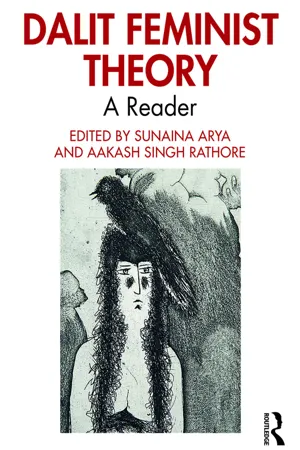
Dalit Feminist Theory
A Reader
- 246 pages
- English
- ePUB (mobile friendly)
- Available on iOS & Android
About this book
Dalit Feminist Theory: A Reader radically redefines feminism by introducing the category of Dalit into the core of feminist thought. It supplements feminism by adding caste to its study and praxis; it also re-examines and rethinks Indian feminism by replacing it with a new paradigm, namely, that caste-based feminist inquiry offers the only theoretical vantage point for comprehensively addressing gender-based injustices.
Drawing on a variety of disciplines, the chapters in the volume discuss key themes such as Indian feminism versus Dalit feminism; the emerging concept of Dalit patriarchy; the predecessors of Dalit feminism, such as Phule and Ambedkar; the meaning and value of lived experience; the concept of Difference; the analogical relationship between Black feminism and Dalit feminism; the intersectionality debate; and the theory-versus-experience debate. They also provide a conceptual, historical, empirical and philosophical understanding of feminism in India today.
Accessible, essential and ingenious in its approach, this book is for students, teachers and specialist scholars, as well as activists and the interested general reader. It will be indispensable for those engaged in gender studies, women's studies, sociology of caste, political science and political theory, philosophy and feminism, Ambedkar studies, and for anyone working in the areas of caste, class or gender-based discrimination, exclusion and inequality.
Frequently asked questions
- Essential is ideal for learners and professionals who enjoy exploring a wide range of subjects. Access the Essential Library with 800,000+ trusted titles and best-sellers across business, personal growth, and the humanities. Includes unlimited reading time and Standard Read Aloud voice.
- Complete: Perfect for advanced learners and researchers needing full, unrestricted access. Unlock 1.4M+ books across hundreds of subjects, including academic and specialized titles. The Complete Plan also includes advanced features like Premium Read Aloud and Research Assistant.
Please note we cannot support devices running on iOS 13 and Android 7 or earlier. Learn more about using the app.
Information
Part I
Indian feminism vs Dalit feminism
1
A critical view on intersectionality1
Two sets of questions
‘Woman’ in Indian feminism
Table of contents
- Cover
- Half Title
- Title
- Copyright
- Dedication
- Contents
- List of figures
- Notes on contributors
- Acknowledgements
- Introduction: theorising Dalit feminism
- Part I Indian feminism vs Dalit feminism
- Part II Predecessors of Dalit feminism
- Part III Lived experience as ‘difference’
- Part IV What difference does ‘difference’ make?
- Part V Intersectionality in India
- Part VI Toward a Dalit feminist theory
- Index